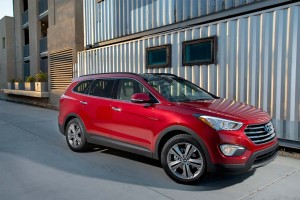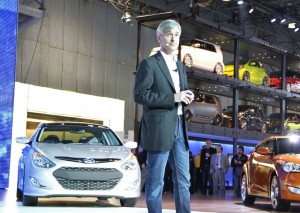Hyundai has set sales records in each of the last two months yet could still wind up losing market share this year because of a chronic shortage of vehicles.
The problem is one of global scale and reflects the maker’s cautious approach to boosting production capacity, Hyundai Motor America Chief Executive Officer John Krafcik told TheDetroitBureau.com. But the Korean carmaker is beginning to look for ways to address the situation.
There is a positive side to the shortage. It has reinforced Hyundai’s effort to transform itself from a “value-based brand to a valuable brand,” according to Krafcik, and in the process, the maker has been able to cut incentives while average transaction prices have jumped to record highs on most of its products.
“We’ve never sold as many cars in January and February as we did in the first two months of this year,” Krafcik noted.
Hyundai expect its sales to grow somewhere between 2% to 4% this year. But the growth is limited by capacity constraints that are leaving the Korean automaker short of some models – and lagging behind the overall pace of recovery in the U.S. market. Its share in recent months has slipped to 4.6%, off from a 5% peak.
Hyundai continues to try and squeeze out more units from its assembly plant in Alabama, recently adding a third shift, but the fact is the South Korean automaker is facing challenges as it tries to keep up with demand.
The company’s transaction prices have increased by more than $700 per unit in recent months, Krafcik noted. Meanwhile, incentives, except for customer loyalty type awards, have been all but eliminated. According to data collected by TrueCar.com, givebacks averaged just $1,420 a vehicle in February, lower than any other major maker in the U.S. market but Honda.
The rising demand has some products particularly hard, including the compact Elantra and larger Sonata sedans, and the new Santa Fe Sport crossover. The maker is looking for ways to to boost delivery of the new Santa Fe 3-row CUV it is just launching.
The new long-wheel, six-or seven-passenger version of the Santa Fe will come from South Korea rather than from the company’s $1.7 billion assembly plant near Montgomery, Alabama, where the five-passenger Santa Fe Sport already is being assembled on three shifts.
The long-wheel base Santa Fe, which is reaching showrooms across the country this month, is also being shipped from South Korea to market it’s the Middle East and in Europe, he added. And that complicates matters, said Krafcik, as growing demand around the world is straining production capacity at all of Hyundai’s factories.
However, despite the company’s recent sales success, Hyundai’ senior management is reluctant to add more capacity. It’s an appropriate time to “pause” said Krafcik, who stressed that by using this moment to focus on such issues as design, drive dynamics and quality, Hyundai will ultimately ensure its longer-term success.
“They are absolutely committed to making sure the quality is right,” he said.
It’s difficult for any manufacturer to give up sales in the short term but it’s better for the company overall, he said.
Paul A. Eisenstein contributed to this report.


